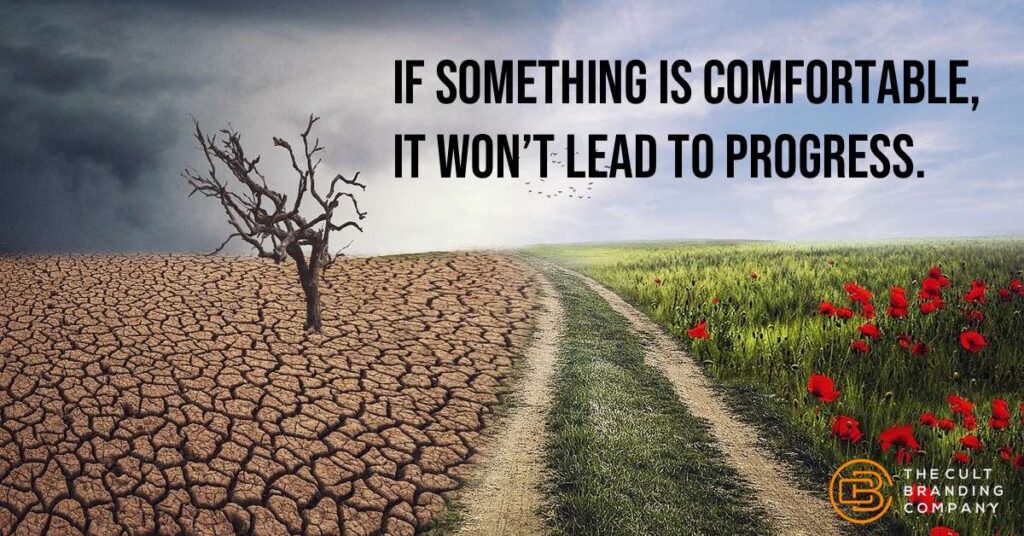Embrace Discomfort, Create Change

Growth was seen as an endless series of daily choices and decisions in each of which one can choose to go back toward safety or forward toward growth. Growth must be chosen again and again; fear must be overcome again and again.Abraham H. Maslow[1. Abraham H. Maslow, The Psychology of Science: A Reconnaissance, 1966.]
If you’re comfortable, you’re not growing. It’s the uncomfortable things that make us grow.
The same is true of business: companies that embrace discomfort as a regular part of business life are more likely to achieve their goals and move closer and closer to fulfilling their company vision than those that don’t.
Companies that stay comfortable—which feels great in the moment—end up losing in the long run, which doesn’t feel so great.
Discomfort is a prerequisite for change.
Love The Customers You Have
You’re a better designer if you love the people you’re designing for. Fred Dust, IDEO Partner, quoted in Bernadette Jiwa’s Meaningful I’m surprised how many companies don’t love their customers. They talk about being customer-centric or even customer-obsessed, but they don’t love the customer they have. Instead,...
Build A Campfire: How To Succeed On Social Media
Today the campfire is called a computer or a television … Drama goes back to the beginning of civilization around the campfire, where the tribe comes together, and they say, “My God, did you see what blah blah did with that mountain lion today?” And the other guy says, “I’ll tell you one better than that.” … [W}e tell stories that unite the tribe. We reinforce our tribal unity. We say, this is how we do things here. David Mamet, MasterClass.comIf the computer is the new campfire, social media is the biggest campfire ever built. Most companies invest a lot of money in social media because they know they have to. But, few know what to do with it.
The Novelty Paradox: Why Your Attractive New Ad May Make Your Brand Less Meaningful
Most commercial messages contain too many elements, all competing with one another for our understanding, and the elements themselves may be uninteresting, unclear, or off-message. Marty Neumeier, ZagCompanies try to make their brands stand out and be different: they try to constantly be new to gain a competitive advantage. In short, they use newness as a path to relevance. But, this quest to be relevant has affected their ability to be meaningful.
Delivering Magic
Magic has long held a special place in the nation’s history. American magicians perform in arenas, theaters, and even backyards. No matter how big or small, a magic show will always inspire wonder. Today as a member of the Citizens’ Stamp Advisory Committee, I am honored...
Do You Feel Like You’re Maximizing Your Marketing Dollars?
Now what do you want out of me? Fine writing? Do you want masterpieces? Do you want glowing things that can be framed by copywriters? Or do you want to see the goddamned sales curve stop moving down and start moving up? Rosser Reeves in Dennis...
Everybody is a Marketer
“Accounting is a department. Marketing isn’t. Marketing is something everyone in your company is doing 24/7/365.” Jason Fried and David Heinemeier Hansson, Rework A brand isn’t a name or a logo: it’s the perception people have of your organization. Everything your company and employees do contribute to...
Cult Brands are Inclusive
In Alexander the Great’s conquest of Persia, the Macedonian King upset his military compatriots and childhood friends by marrying Roxana. Roxana was the daughter of a minor Persian baron. That is, she was not from Macedonia; she was not of Greek blood. This outraged Alexander’s men who...
How to Become a Cult Brand
THE BIG IDEA: Certain businesses excel at fostering undying, cult-like following among their customers. Our study of Cult Brands reveals seven rules any business can follow to attract loyal customers. ______________ Some customers have a religious devotion to a particular brand. They may go so far as...

